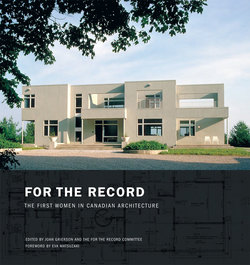Читать книгу For the Record - Joan Grierson - Страница 9
ОглавлениеVitruvius, Palladio, Christopher Wren, Thomas Jefferson, Frank Lloyd Wright and Le Corbusier – these are just a few of the many great architects who have been recognized over the centuries. Many kings but no queens. There is a legend that Jane Wren, daughter of Christopher Wren who was charged with the rebuilding of London’s churches after the Great Fire of 1666, was responsible during her brief life for work on three Wren churches in east London. By the late nineteenth century, a few women architects had appeared but it was not until the second half of the twentieth century that women entered architecture in significant numbers.
This book is about women in architecture, yesterday and today, and about the establishment in Canada of the profession itself. Prior to 1890, architectural training in Canada was acquired through apprenticeship. Starting that year, courses in architecture were offered at the University of Toronto; in 1896, McGill University in Montreal followed suit. Today, there are eleven architectural programs at universities across the country.
It was from the Department of Architecture at the University of Toronto that Marjorie Hill graduated in 1920, the first “girl architect,” as described by a Toronto newspaper at the time. For the Record profiles Marjorie Hill and some of the women who followed her. They were among the first women to become architects in Canada.
Although this book focuses on the early women graduates in Architecture at the University of Toronto, three distinguished architects who were trained elsewhere should be mentioned: Catherine Chard Wisnicki, Phyllis Lambert and Blanche Lemco van Ginkel. Above and beyond their design work, these three women have made outstanding contributions to education within the profession.
Catherine Chard Wisnicki was the first woman to graduate in Architecture from McGill, in 1943. She was an active participant in the development of west coast modernism and taught for over twenty years in the School of Architecture at the University of British Columbia until her retirement in 1986.
Phyllis Lambert holds a master’s degree in Architecture from the Illinois Institute of Technology and had an award-winning architectural practice based in Montreal. In 1979, she founded the Canadian Centre for Architecture, a museum and international centre for architectural research – based on the conviction that architecture is an urgent public concern.
Blanche Lemco van Ginkel graduated from McGill in Architecture in 1945 and completed her master’s degree in City Planning at Harvard five years later. A distinguished educator as well as a successful architect and planner, van Ginkel was Director, then Dean of Architecture at the University of Toronto from 1977 to 1982.
Researched and written by women architects, this book speaks in a collective voice. It is our intention to provide information about the profession of architecture and to follow the part that women have played in it from the early years. That there have been many changes over time is apparent in the final chapter, which presents the work of six women architects working today, selected from across the country.
It has taken us twenty years to publish this book, the same length of time Marjorie Hill had to wait to practice architecture. We bow to her patience and fortitude.
